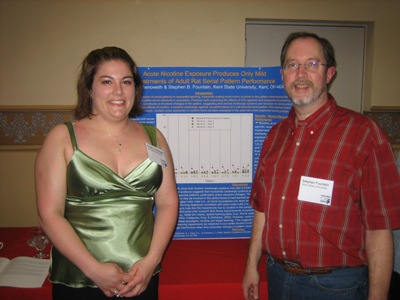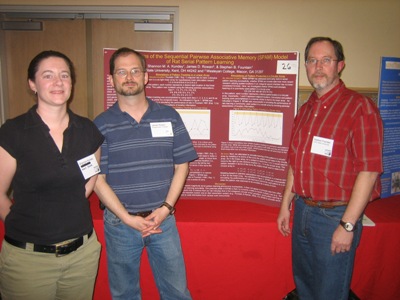| Conference Talk Abstract:
Distinct Behavioral and Brain Processes Subserving
Serial Pattern Learning
Stephen B. Fountain, Denise P. A. Smith, Amber M.
Chenoweth (Kent State University), James D. Rowan (Wesleyan College),
Melissa D. Muller (Mount Union College), Laura R. Glass, & Shannon M.
Kundey (Kent State University)
Our recent studies have shown that different
aspects of serial pattern learning and performance can be disrupted by
different drug and brain lesion manipulations. We will summarize the
differential effects of a) acute systemic administration of the drug,
MK-801, an NMDA-receptor antagonist, b) dorsal hippocampal lesions, c)
medial caudate-putamen lesions, d) acute administration of the
muscarinic cholinergic antagonist drugs, atropine and scopolamine, and
e) acute and chronic nicotinic cholinergic agonists and antagonists. The
differential effects of these neurobiological manipulations fit well
with claims that serial pattern learning involves multiple concurrent
psychological processes including stimulus-response learning, multiple
item memory, counting or timing, chunking, and rule learning. Taken
together, the results of the foregoing studies show that the serial
pattern learning paradigm is an excellent model system for examining the
contribution of multiple cognitive and neural processes that contribute
to performance in a single task.
Poster Presentation Abstracts:

Acute Nicotine Exposure Produces Only Mild
Impairments of Adult Rat Serial Pattern Performance.
PDF
Amber M. Chenoweth & Stephen B. Fountain (Kent
State University)
We examined effects of nicotine, a nicotinic
cholinergic agonist, on performance of a well-learned serial pattern.
Rats were trained to press levers in a sequential pattern: 123 234 345
456 567 678 781 818, where digits represent the clockwise position of
levers in a circular array, spaces indicate 3-s pauses, and other ITIs
were 1 s. Once rats reached a high criterion, they received a relatively
high dose of nicotine (0.4 mg/kg i.p.) for three successive days. On Day
1 but not thereafter, nicotine produced small but significant
impairments on the first element of chunks and on the final “violation”
element that was inconsistent with pattern structure. Nicotine never
affected within-chunk performance. Because muscarinic cholinergic
antagonists such as atropine and scopolamine cause severe deficits in
pattern performance, these small nicotine effects add to the evidence
that muscarinic cholinergic systems play a more important role in
pattern performance than nicotinic systems.

Some Limitations of the Sequential Pairwise
Associative Memory (SPAM) Model of Rat Serial Pattern Learning.
PDF
Shannon M. Kundey (Kent State University), James
D. Rowan (Wesleyan College), & Stephen B. Fountain (Kent State
University)
Wallace & Fountain (2002, 2003) showed that the
sequential pairwise associative memory (SPAM) model, a computational
model based on pairwise associations and generalization, could simulate
a variety of rat serial pattern learning phenomena for sequences
composed of successive food quantities. In the present studies, we
examined how well SPAM simulates earlier data from rat serial pattern
learning studies in two different paradigms, namely, a stimulus
anticipation paradigm in a 6-light linear array and a pattern production
paradigm in which rats anticipated the successive positions of correct
responses in an 8-lever circular array. In both paradigms, patterns were
highly structured and extensively “branching” sequences of positions in
the arrays (i.e., the sequences were characterized by cues that signaled
different events at different points in the pattern). SPAM failed to
simulate rats’ performance in both these paradigms. We examine possible
reasons for SPAM’s failures in these paradigms and suggest possible
remedies.
|